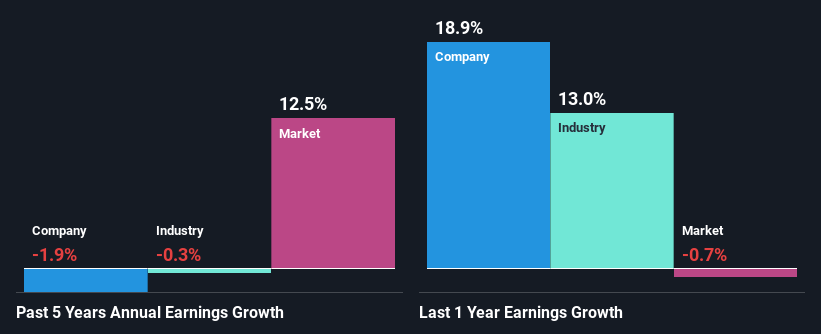- United States
- /
- Pharma
- /
- NYSE:JNJ
Are Johnson & Johnson's (NYSE:JNJ) Fundamentals Good Enough to Warrant Buying Given The Stock's Recent Weakness?

It is hard to get excited after looking at Johnson & Johnson's (NYSE:JNJ) recent performance, when its stock has declined 2.6% over the past week. However, stock prices are usually driven by a company’s financials over the long term, which in this case look pretty respectable. Specifically, we decided to study Johnson & Johnson's ROE in this article.
Return on equity or ROE is an important factor to be considered by a shareholder because it tells them how effectively their capital is being reinvested. In simpler terms, it measures the profitability of a company in relation to shareholder's equity.
View our latest analysis for Johnson & Johnson
How Is ROE Calculated?
The formula for return on equity is:
Return on Equity = Net Profit (from continuing operations) ÷ Shareholders' Equity
So, based on the above formula, the ROE for Johnson & Johnson is:
21% = US$15b ÷ US$70b (Based on the trailing twelve months to September 2024).
The 'return' is the income the business earned over the last year. That means that for every $1 worth of shareholders' equity, the company generated $0.21 in profit.
Why Is ROE Important For Earnings Growth?
So far, we've learned that ROE is a measure of a company's profitability. Depending on how much of these profits the company reinvests or "retains", and how effectively it does so, we are then able to assess a company’s earnings growth potential. Assuming all else is equal, companies that have both a higher return on equity and higher profit retention are usually the ones that have a higher growth rate when compared to companies that don't have the same features.
Johnson & Johnson's Earnings Growth And 21% ROE
To start with, Johnson & Johnson's ROE looks acceptable. And on comparing with the industry, we found that the the average industry ROE is similar at 21%. However, we are curious as to how Johnson & Johnson's decent returns still resulted in flat growth for Johnson & Johnson in the past five years. Based on this, we feel that there might be other reasons which haven't been discussed so far in this article that could be hampering the company's growth. These include low earnings retention or poor allocation of capital.
As a next step, we compared Johnson & Johnson's performance with the industry and found thatJohnson & Johnson's performance is depressing even when compared with the industry, which has shrunk its earnings at a rate of 0.3% in the same period, which is a slower than the company.

Earnings growth is a huge factor in stock valuation. What investors need to determine next is if the expected earnings growth, or the lack of it, is already built into the share price. This then helps them determine if the stock is placed for a bright or bleak future. Has the market priced in the future outlook for JNJ? You can find out in our latest intrinsic value infographic research report.
Is Johnson & Johnson Using Its Retained Earnings Effectively?
With a high three-year median payout ratio of 71% (implying that the company keeps only 29% of its income) of its business to reinvest into its business), most of Johnson & Johnson's profits are being paid to shareholders, which explains the absence of growth in earnings.
In addition, Johnson & Johnson has been paying dividends over a period of at least ten years suggesting that keeping up dividend payments is way more important to the management even if it comes at the cost of business growth. Our latest analyst data shows that the future payout ratio of the company is expected to drop to 50% over the next three years. Accordingly, the expected drop in the payout ratio explains the expected increase in the company's ROE to 33%, over the same period.
Conclusion
Overall, we feel that Johnson & Johnson certainly does have some positive factors to consider. Yet, the low earnings growth is a bit concerning, especially given that the company has a high rate of return. Investors could have benefitted from the high ROE, had the company been reinvesting more of its earnings. As discussed earlier, the company is retaining a small portion of its profits. Having said that, looking at current analyst estimates, we found that the company's earnings growth rate is expected to see a huge improvement. To know more about the company's future earnings growth forecasts take a look at this free report on analyst forecasts for the company to find out more.
New: Manage All Your Stock Portfolios in One Place
We've created the ultimate portfolio companion for stock investors, and it's free.
• Connect an unlimited number of Portfolios and see your total in one currency
• Be alerted to new Warning Signs or Risks via email or mobile
• Track the Fair Value of your stocks
Have feedback on this article? Concerned about the content? Get in touch with us directly. Alternatively, email editorial-team (at) simplywallst.com.
This article by Simply Wall St is general in nature. We provide commentary based on historical data and analyst forecasts only using an unbiased methodology and our articles are not intended to be financial advice. It does not constitute a recommendation to buy or sell any stock, and does not take account of your objectives, or your financial situation. We aim to bring you long-term focused analysis driven by fundamental data. Note that our analysis may not factor in the latest price-sensitive company announcements or qualitative material. Simply Wall St has no position in any stocks mentioned.
About NYSE:JNJ
Johnson & Johnson
Researches, develops, manufactures, and sells various products in the healthcare field worldwide.
Established dividend payer and good value.

